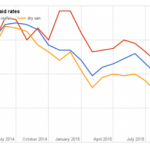The US dollar is firm against the major currencies and nearly all the emerging market currencies as well to close out the week (and month). Participants are clearly focused on next week’s events, and in particular, the prospect of additional easing measures by the ECB. Also, next week’s speeches by Yellen and the monthly jobs report is expected to underpin expectations for the Fed’s lift-off in the middle of December.

However, before those events, China is very much center stage. The Shanghai Composite slumped nearly 5.5%, and the Shenzhen Composite lost 6.1%, the largest losses since August’s rout. The proximate cause appears to be news that the three top brokers are under investigation as part of the larger anti-corruption campaign. News that corporate profits fell 4.6% in October after a 0.1% decline in September also weighed on investor sentiment.
The dollar rose to two-month highs against the yuan while the gap between the offshore (CNH) and onshore (CNY) yuan widened to about 0.9%. This is the widest since early-September. Although the PBOC is thought to have tried to minimize the gap before it reached this magnitude in the past, its agents have not been seen. Perhaps some of the tolerance are linked to speculation ahead of Monday’s IMF decision. That the yuan is included seems to be a forgone conclusion. The issue now is the weight it is given in the basket.
In a report over the summer, the IMF staff suggested that if just exports are used for the calculation of the yuan’s share of global reserves is very low (~1.1%), the weighting would be 14%-16%. However, the use of the yuan is well below the other members of the SDR basket (dollar, euro, sterling and yen). The market consensus, according to one newswire is for about a 10% weighting. We suspect that it may be a bit lower. For Chinese officials getting in is the important thing. The weighting is less significant. It can be confident that as the yuan’s role in the global economy increases, so will its weight in the SDR.












Leave A Comment